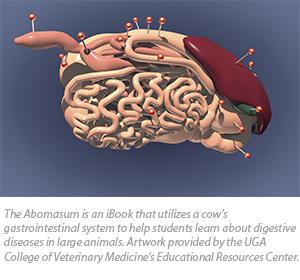 In a field where didactic teaching methods predominate, students at the UGA CVM are being provided a rare opportunity to take an active role in their education. Faculty throughout the College are developing and implementing dynamic, often case-based, educational tools for use in their classrooms, evolving the learning experience from one of passive observation to one filled with active investigation, interaction and choice; in short, an education that mimics real-life in a veterinary practice.
In a field where didactic teaching methods predominate, students at the UGA CVM are being provided a rare opportunity to take an active role in their education. Faculty throughout the College are developing and implementing dynamic, often case-based, educational tools for use in their classrooms, evolving the learning experience from one of passive observation to one filled with active investigation, interaction and choice; in short, an education that mimics real-life in a veterinary practice.
Brenton Credille, DVM, PhD, DACVIM, an assistant professor of beef production medicine, co-developed and recently debuted a “glass cow” iBook for third-year students studying large animal digestive diseases. Credille wanted his students to be able to visualize disease in real time before they encountered it on the job. 
Credille worked closely with graphic designers and medical illustrators in the CVM’s Educational Resources Center (ERC) for three years to develop the tool. He debuted it as a downloadable iBook called The Abomasum, named after the cud-chewing animals’ fourth stomach, in September 2016. The tool works as an interactive text for his students and is free for them to download. The tool’s primary goal is to give students a better understanding of diseases that commonly affect a cow’s gastrointestinal tract.
“Students are often only exposed to drawings or our spoken word explanations when we describe these disorders and many don’t seem to have a solid grasp of what is truly happening,” he says. “This tool gives students an interactive means to explore these diseases so that they feel more comfortable when they encounter them in clinical practice.”
The iBook opens with basic abdomen anatomy—a subject in which most third-year veterinary students are well versed. Unlike their previous textbooks that discussed this topic, the images in The Abomasum expand and rotate to reveal all 360 degrees of the organ. But what really excites students, says Credille, is the next section of the  book that explains and—better yet—shows common cattle digestive disease in real time. Animated videos show how diseases, like abomasal volvulus that can fatally restrict blood flow to the fourth stomach, affect organs over time. Credille says the 3-D imaging helps students mentally plan for what they will encounter in the field. The idea being, if they’re more familiar with the disease logistics and progression, they’ll be able to more efficiently approach treatment and prognosis in the future.
book that explains and—better yet—shows common cattle digestive disease in real time. Animated videos show how diseases, like abomasal volvulus that can fatally restrict blood flow to the fourth stomach, affect organs over time. Credille says the 3-D imaging helps students mentally plan for what they will encounter in the field. The idea being, if they’re more familiar with the disease logistics and progression, they’ll be able to more efficiently approach treatment and prognosis in the future.
